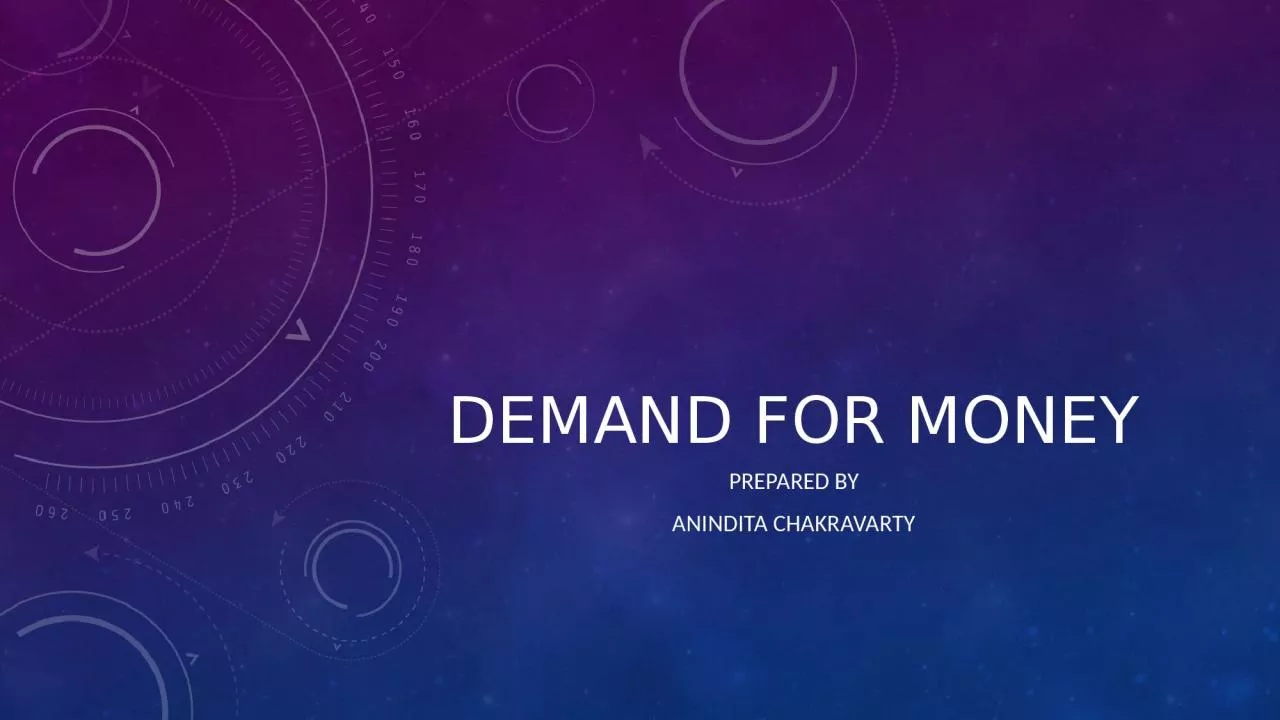

Anindita chakravarty What is Demand for Money The demand for money is the total amount of money that the population of an economy wants to hold The three main reasons to hold money as opposed to ID: 1027283
Download Presentation The PPT/PDF document "Demand for money Prepared by" is the property of its rightful owner. Permission is granted to download and print the materials on this web site for personal, non-commercial use only, and to display it on your personal computer provided you do not modify the materials and that you retain all copyright notices contained in the materials. By downloading content from our website, you accept the terms of this agreement.
1. Demand for moneyPrepared byAnindita chakravarty
2. What is Demand for Money?The demand for money is the total amount of money that the population of an economy wants to hold.The three main reasons to hold money, as opposed to bonds, equity, or other financial asset classes, are as follows:A transactions-related reason – People need money on a regular basis to pay bills and finance their discretionary consumption;A precautionary reason, as an unexpected need, can often arise; andA speculative reason if they expect the value of such money to increase versus other asset classes.
3. Transaction motiveThe transactions motive for demanding money arises from the fact that most transactions involve an exchange of money. Because it is necessary to have money available for transactions, money will be demanded. The total number of transactions made in an economy tends to increase over time as income rises. Hence, as income or GDP rises, the transactions demand for money also rises. The transactions demand for money depends only on the real income and is not influenced by the rate of interest.
4. Precautionary motivePeople often demand money as a precaution against an uncertain future. Unexpected expenses, such as medical or car repair bills, often require immediate payment. The need to have money available in such situations is referred to as the precautionary motive for demanding money.
5. Speculative motiveMoney, like other stores of value, is an asset. The demand for an asset depends on both its rate of return and its opportunity cost. Typically, money holdings provide no rate of return and often depreciate in value due to inflation. The opportunity cost of holding money is the interest rate that can be earned by lending or investing one's money holdings. The speculative motive for demanding money arises in situations where holding money is perceived to be less risky than the alternative of lending the money or investing it in some other asset.
6. The speculative motive of the people relates to the desire to hold one’s resources in liquid form in order to take advantage of market movements regarding the future changes in the rate of interest (or bond prices).The notion of holding money for speculative motive was a new and revolutionary Keynesian idea. If bond prices are expected to rise which, in other words, means that the rate of interest is expected to fall, businessmen will buy bonds to sell when their prices actually rise. If, however, bond prices are expected to fall, i.e., the rate of interest is expected to rise, businessmen will sell bonds to avoid capital losses.Thus the demand for money under speculative motive is a function of the current rate of interest, increasing as the interest rate falls and decreasing as the interest rate rises. Thus, demand for money under this motive is a decreasing function of the rate of interest
7. Along X-axis we represent the speculative demand for money and along the y-axis the current rate of interest.The liquidity preference curve LP is downward sloping towards the right signifying that the higher the rate of interest, the lower the demand for money for speculative motive, and vice versa. This is because at a high current rate of interest more money would have been lent out or used for buying bonds and therefore less money would be kept as inactive balances.
8. LIQUIDITY TRAPThe liquidity preference curve LP becomes quite flat i.e., perfectly elastic at a very low rate of interest; it is horizontal line beyond point E” towards the right. This perfectly elastic portion of liquidity preference curve indicates the position of absolute liquidity preference of the people. That is, at a very low rate of interest people will hold with them as inactive balances any amount of money they come to have.This portion of liquidity preference curve with absolute liquidity preference is called liquidity trap by the economists because expansion in money supply gets trapped in the sphere of liquidity trap and therefore cannot affect rate of interest and therefore the level of investment. According to Keynes, it is because of the existence of liquidity trap that monetary policy becomes ineffective to tide over economic depression.
9. THANKS